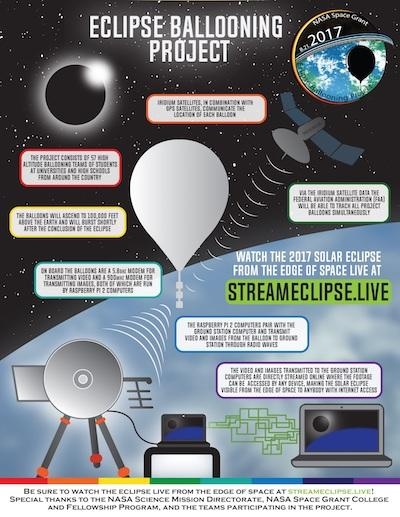Student Teams Across The Country Will Launch High-Altitude Balloons Along Eclipse Path
It has been a long time since German pop singer Nena wowed 1980s teenyboppers with her hit about “99 Red Balloons” – almost as long ago as the last total eclipse over the U.S. mainland, in 1979. But this summer, talk of balloons and eclipses will be in the air together.

In partnership with NASA, 58 student teams across the country will launch nearly 100 high-altitude balloons to capture live footage of the eclipse. And with so many unmanned balloons floating toward near space on the same day, the ATO is taking steps to make sure the personnel at relevant air traffic facilities know about it.
Airspace Services Deputy Director Gary Norek emphasized that the project isn’t considered high risk. But he added, “If we were to tell nobody about this at all, then controllers might be surprised about the number of reports of balloons that they get.”
Solar eclipses are rare and total solar eclipses, rarer still. A total eclipse occurs when the moon passes between the Earth and the Sun, casting a shadow on the Earth. Totality, the point at which the moon completely blocks the sun, is brief and appears along a narrow path. The only people in the United States who could see the last total eclipse in July 1991 were in Hawaii. The February 1979 eclipse was visible from a few Northwestern states. By contrast, the path of this year’s Aug. 21 eclipse – the first of the digital age – will stretch across 12 states from Oregon to South Carolina, and the Eclipse Ballooning Project aims to make the most of it.
Teams of high school and college students from 31 states are part of the project, which has been planning for the eclipse since June 2015. Each balloon will carry four payloads – two cameras to transmit photos and high-definition video to a ground station, a satellite modem for tracking the balloon’s location, and a select team payload for a science project.
The FAA learned about the project through Berk Knighton, who heads the ballooning program at Montana State University and who has worked with the FAA for years in that role. He also serves on the Aviation Rulemaking Committee for ballooning that the FAA created last year. Knighton initially told his contacts at Salt Lake Center about the Eclipse Ballooning Project. That led to connections in the Western Service Area and eventually at headquarters. While the centers are used to handling high-altitude balloon operations – Norek said the National Weather Service has tens of thousands of them per year – this project is different because dozens will take flight in a short period of time. “They may get more reports of balloon operations than they do any other day,” Norek said.
Patrick Moorman, an air traffic control specialist on the Airspace and Rules Team in Mission Support Services, is the FAA’s point man for spreading the word about the project. He is working with Knighton to inform several air route traffic control centers. In addition to Salt Lake Center, the centers in Atlanta, Denver, Jacksonville, Indianapolis, Kansas City, Memphis, Minneapolis-St. Paul and Seattle may see eclipse-related balloon traffic in their airspace. “I feel pretty strongly that operations like mine should be coordinating more closely with the FAA so that people know what we’re doing,” Knighton said. “And that’s a little challenging because there’s no federal statute” that requires it for many of the balloons in the project.
Moorman said the organizers of the project are “trying to be good neighbors,” with Knighton serving as the conduit between the FAA and the various balloon teams. “For balloons, there’s no tool that we have to separate or segregate them from normal traffic.”
To keep the FAA in the loop, Knighton is developing a list of balloon operations for both the day of the eclipse and a June 20 practice run. The list will identify the balloon operators, launch locations, payload weights, expected trajectories and recovery locations, among other details. “We are working hard to bring everybody on board so there’s a pretty well-set expectation of how we expect them to conduct their operations,” Knighton said.
Moorman will distribute that information to the centers and give Knighton of list of contact names at the center. Moorman also is working with FAA colleagues to standardize the notices to airmen for the various balloon operations, with the goal of issuing one NOTAM per center. And he will notify the Defense Department and airline industry groups about the project.
Knighton said working with the FAA on the Eclipse Ballooning Project has been rewarding, and he hopes the experience will add value to his work on the Aviation Rulemaking Committee for ballooning. “It certainly has brought a lot of credibility to my program,” he said.
(Source: Montana Space Grant Consortium news release. Infographic provided by NASA)
 ANN's Daily Aero-Term (04.24.24): Runway Lead-in Light System
ANN's Daily Aero-Term (04.24.24): Runway Lead-in Light System ANN's Daily Aero-Linx (04.24.24)
ANN's Daily Aero-Linx (04.24.24) Aero-FAQ: Dave Juwel's Aviation Marketing Stories -- ITBOA BNITBOB
Aero-FAQ: Dave Juwel's Aviation Marketing Stories -- ITBOA BNITBOB Classic Aero-TV: Best Seat in The House -- 'Inside' The AeroShell Aerobatic Team
Classic Aero-TV: Best Seat in The House -- 'Inside' The AeroShell Aerobatic Team Airborne Affordable Flyers 04.18.24: CarbonCub UL, Fisher, Affordable Flyer Expo
Airborne Affordable Flyers 04.18.24: CarbonCub UL, Fisher, Affordable Flyer Expo



